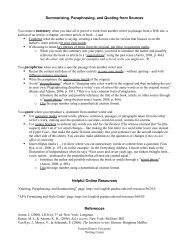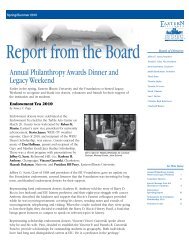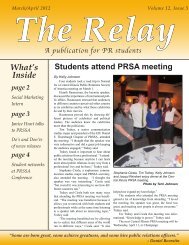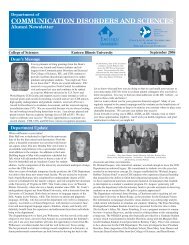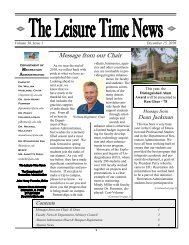Create successful ePaper yourself
Turn your PDF publications into a flip-book with our unique Google optimized e-Paper software.
preposterous to me that any reasonable person could argue otherwise.<br />
However, pornography has always sparked heated debate.<br />
Many differing points of view about pornography have been passionately<br />
discussed here at EIU as a result of Dines’s presentation.<br />
Many individuals argue that pornographers should have the right<br />
to produce and sell porn because to restrict them would infringe<br />
on their freedom of speech. Often, the people who make this argument<br />
are the same people who choose not to view pornography<br />
and are blissfully unaware of the content of many pornographic<br />
films, magazines, and internet sites. In order to develop an informed<br />
opinion on the subject, I believe that people need to be<br />
exposed to the material at the heart of the discussion. Dines was<br />
a dynamic, articulate speaker who analyzed the production and<br />
consumption of pornography with a keen feminist sensibility. She<br />
has her own firmly held convictions, but ultimately, she challenged<br />
her audience to develop an informed opinion for themselves about<br />
the consequences of pornography.<br />
Tiffany Swiderek, student, WST 2309:<br />
I left Gail Dines’s presentation on pornography with a whole new<br />
outlook on something I used to blow off as “boys will be boys.”<br />
Dines defined pornography as sexualizing abuse of women, and<br />
drove her point home with numerous images, explanations, and<br />
stories.<br />
I always knew Playboy, Playpen, and Hustler were three of the<br />
most popular “men’s” magazines. I never realized how explicit,<br />
demeaning, and abusive Hustler magazine was towards women.<br />
First of all, I can’t believe some of the images they print are even<br />
legal, and second of all, I can’t imagine what kind of sick male<br />
would actually get off looking at something so disgusting and<br />
unrealistic.<br />
Dines talked about abuse of women and children and how images<br />
of pornography act as “scripts” for men to act out. . . . I left the<br />
presentation shocked that pornography has such a huge impact<br />
on today’s society.<br />
Newsletter Staff<br />
Director of <strong>Women</strong>’s Studies: Diana Slaveiro<br />
Newsletter Editors: Ruth Hoberman and Lynanne Page<br />
Newsletter Design: Stacia Lynch<br />
Sace Elder, Assistant Professor, History:<br />
It is a testament to the merits of Gail Dines’s talk that there has<br />
been so much discussion of her presentation on campus since<br />
March 7. Graduate students in my modern European women’s history<br />
course, for example, spent a good hour debating the issue of<br />
pornography and making fruitful comparisons between contemporary<br />
debates about pornography and the late nineteenth-century<br />
feminist debates about prostitution. Dines’s powerful images and<br />
provocative language effectively conveyed the misogyny typical<br />
of the porn industry. Pornography that begins with the playful<br />
images of Playboy Playmates shades – inexorably, Dines argues<br />
– into the much more sexually explicit and misogynist Hustler<br />
FEEDBACK FEEDBACK FEEDBACK FEEDBACK FEEDBACK<br />
FEEDBACK FEEDBACK FEEDBACK FEEDBACK FEEDBACK<br />
FEEDBACK FEEDBACK FEEDBACK FEEDBACK FEEDBACK<br />
FEEDBACK FEEDBACK FEEDBACK FEEDBACK FEEDBACK<br />
FEEDBACK FEEDBACK FEEDBACK FEEDBACK FEEDBACK<br />
FEEDBACK FEEDBACK FEEDBACK FEEDBACK FEEDBACK<br />
Dines<br />
and finally into the graphic sexual violence of snuff films and<br />
internet porn. Clearly the popularity of these representations of<br />
the sexualized female body (the porn industry grosses more than<br />
movies and video games, Dines tells us) as well as the conditions<br />
under which many of those real women work in producing those<br />
images reveal the persistence of male domination in our society (I<br />
would not call it “patriarchy” as Dines does) as well as an alarming<br />
disconnect between male and female sexuality. Pornography has<br />
consequences not just for women but for men as well: How is it<br />
possible, Dines asks us, for men and women to have truly intimate<br />
and human sexual relationships when the male sexual imagination<br />
is shaped by such violent and disturbing images?<br />
It would be difficult to argue that the disturbing images Dines<br />
presented were not exploitative of the women in them. In the<br />
end, it is the production of these images and the issues of labor<br />
that should be of the most immediate concern. The conditions<br />
of labor that place women, in particular, at risk and the alienation<br />
of these women from the enormous capital their labor generates<br />
are symptomatic of a capitalist society that is and has historically<br />
been dependent upon an abundant supply of cheap female labor.<br />
Such was also Dines’s self-professedly Marxist critique of the porn<br />
industry, although she spent little time discussing how these labor<br />
issues might be addressed.<br />
There are several aspects of the pornography problem I would<br />
have liked to hear Dines address more adequately. When asked,<br />
for example, if there might be an alternative eroticism that was<br />
affirming of women and promoted human intimacy, Dines had little<br />
to say. This issue seems to have been of particular concern to one<br />
remarkably frank young man in the audience, who wondered how<br />
he could imagine sex differently than how it is portrayed by the<br />
pornographers. Dines told the young man she was sorry his sexuality<br />
had been hijacked and that she didn’t know if he would ever<br />
be able to reclaim it. Not very encouraging, and yet alternatives<br />
are crucial if we hope to develop into fully realized sexual individuals.<br />
And it seems that in the case of this young man (and many like<br />
him) the problem isn’t just the pornography, but the sexual moralism<br />
that combats positive and public sex education and forces<br />
youths (primarily young boys) into the arms of pornographers to<br />
learn what they know of sex and female bodies.<br />
Of course, one of Dines’s main points was that young people<br />
don’t even have to visit a porn site or watch an X-rated film to be<br />
“educated” on exploitation. Vanity Fair, Cosmopolitan, Seventeen<br />
– one can find violent and sexually suggestive images of women<br />
everywhere in mainstream media. That there are certain continuities<br />
in the representations of the female form in mainstream media<br />
and pornography is clear (although not all of Dines’s examples<br />
served her well in this regard). What is less clear is why this is so.<br />
Dines seemed to suggest simultaneously that mainstream media<br />
are mimicking the porn industry’s repertoire for financial gain,<br />
and that both popular advertising and pornography operate in<br />
the same cultural register that dominates and exploits women.<br />
One of the key problems to be explained, it seems to me, is why<br />
the sexualized body is necessarily the female body. <strong>Women</strong>’s<br />
magazines feature images of sexy women because those are the<br />
images that suggest to us (men and women alike) sexual desire.<br />
In that sense, the pornographers tap into a hegemonic sexuality in<br />
which women are the objects of desire and the sexual gaze is the<br />
male gaze.<br />
Perhaps to combat pornography we must not only attack the<br />
exploitative ways in which it is produced, but also find alternative<br />
ways of imagining, thinking about, and talking about sexual bodies.<br />
Rich Foley, Assistant Professor, Philosophy:<br />
“I put my arms around him yes and drew him down to me so he<br />
could feel my breasts all perfume yes and his heart was going<br />
like mad and yes I said yes I will Yes.” Does reading this passage<br />
make heterosexual men desire to pluck Molly Bloom’s mountain<br />
flower? Undoubtedly it does, and such desires affect behavior as<br />
well. However, this uncontroversial claim is not sufficient to justify<br />
censorship in the way that Gail Dines suggests.<br />
Minimally, Dines requires the additional claim that the behavior<br />
resulting from enjoying pornography will mimic the behavior depicted<br />
by the pornography. If the aestheticization of rape changes<br />
male behavior, but in a way that is not in fact harmful to women,<br />
then there is no reason to censor it—abridging civil rights can be<br />
justified only by the harm that would result if the rights were not<br />
limited. Although most of Dines’s lecture was designed to support<br />
this claim, I do not believe that her argument was successful.<br />
Indeed, I think her talk was fundamentally inconsistent on this<br />
point given her frequent and often gratuitous use of pornographic<br />
images.<br />
Dines argued that pornography leads men to desire depictions<br />
of women in ever more demeaning sexual positions, and that<br />
ultimately men prefer images of gang-rape or of women depicted<br />
as children. Dines asserts that men will imitate these images,<br />
resulting in violence against women and children. This mimetic<br />
theory originates with Plato’s Republic, yet the refutation is almost<br />
as old, and was offered by Plato’s student, Aristotle. Aristotle<br />
argued (when faced with the violence depicted in Greek tragedy)<br />
that graphic violence enables the audience to purge themselves of<br />
their impure, anti-social drives. Which theory is correct is an empirical<br />
matter, but I suspect that the societies with severe restrictions<br />
on pornography tend to have the greatest repression and<br />
violence against women. It is obvious that pornography affects<br />
behavior, but if Aristotle’s theory of catharsis is correct, restriction<br />
of pornography would lead to an increase of the very behaviors<br />
Dines so justly condemns.<br />
Robin Murray, Associate Professor, English:<br />
A few years into my tenure here at <strong>Eastern</strong>, my colleague Linda<br />
Coleman passed along a quotation from Joanne Callahan that<br />
hangs on my office wall right beside a Georgia O’Keefe print:<br />
“Twenty years ago, I just didn’t understand the radicals’ ideas. But<br />
after seeing liberal feminism’s limitations, my philosophy is becoming<br />
more radical. To my dismay, the effect of all those crucial<br />
liberal feminist reforms was the modernization of patriarchy, not<br />
the abolition of it,” Callahan declares.<br />
The juxtaposition of the quotation with the print speaks well to my<br />
reading of Gloria Steinem’s essay “Body of Knowledge” and illustrates<br />
my discomfort with elements of the recent Gail Dines lecture<br />
on pornography. Like Callahan, I embrace some radical feminist<br />
philosophies, and like O’Keefe, I find the female body beautiful<br />
and erotic—and don’t feel as if I’m objectifying myself or other<br />
women by stating these beliefs. In “Body of Knowledge,” Steinem<br />
articulates for a broad general audience how much of “our sense<br />
of ourselves resides in our body.” While Steinem agrees that<br />
women need to encourage more powerful and positive images of<br />
women in media like film, she also recognizes the importance of<br />
nurturing the body and recognizing its fundamental connection<br />
with the mind. For example, she explains that “new techniques for<br />
tracking the development of the living brain suggest that touch is<br />
the primary source of neurochemical changes in infancy.”<br />
For Steinem, sexuality serves as an integral element of this mindbody<br />
connection and is an essential source for building strong<br />
self-esteem and self-concept. According to a text on the medical<br />
aspects of human sexuality, “Orgasm and other forms of sexual<br />
expression are such a source of self-affirmation that two thirds of<br />
psychiatrists believe people ‘nearly always or often’ lose self-esteem<br />
when deprived of a ‘regular outlet for sexual gratification.’”<br />
A long quote from Steinem will explain why I think Dines misrepresented<br />
women’s sexuality in her talk. For Steinem, orgasm<br />
is so central to our being that, as countless studies have shown,<br />
masturbation is instinctive from a very early age. In later life, sexuality<br />
and sensuality are also ways we express ourselves and ‘talk’<br />
to each other: unlike other animals, for whom sex seems to be<br />
focused in times of ‘heat’ or estrus when conception is most likely,<br />
human sexual pleasure exists independently of conception, and<br />
so is a way we communicate as well as procreate. Given gender<br />
politics, however, men may be so genitally focused that they miss<br />
whole-body sensuousness, while women may focus so much<br />
<strong>Women</strong>’s Studies News April/May 2005 Apruil/May 2005 <strong>Women</strong>’s Studies News




